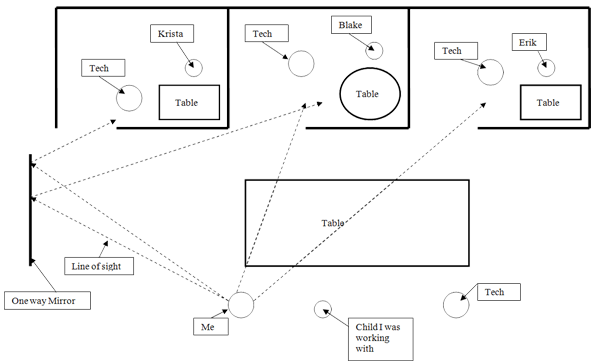Cute Stories from Croyden Avenue School
Echoic Behavior at it’s best by David Eisenhart
One day during our transition to music, which takes place up stairs in a separate room, Nic was in the middle of an all out tantrum; the controlling variables for the tantrum were unknown. During this tantrum Nic had his arms flailing, tears running down his face and a high pitch scream. (That was not the cute part.)
Blake, another student in the classroom, also transitioning to music, is very echoic (imitation of vocal behavior). Blake’s copycat-like behavior to all audible noises and most motor behaviors presented a cute situation. He began to imitate Nic’s tantrum behavior including the arm flailing and the pitch of the scream, all the while, smiling, having a great time, and continuing his transition to music. So as not to miss a movement, Blake leaned to the left, then right, as students and technicians interfered with his view of Nic’s tantrum. Meanwhile, the technician/tutor was doing her best to ignore the pseudo tantrum and not reinforce it with attention by laughing at the pseudo tantrum.
The Difference between the Mand, The Tact, and the Echoic response by David Eisenhart
One day while aiding another technician who was running a procedure at Croyden, I observed a funny demonstration of the mand (request for an item or change in the environment), the tact (a label for an item or stimulus), and echoic behavior (the parrot like repetition of verbal sounds) in the classroom. Below is a model of the classroom giving you a visual aid.
The child, Erik was running a procedure with his technician, and he requested to work with bubbles as his preferred reinforcer. Every time he would get a response correct, Erik would immediately verbally request (mand) for bubbles from the technician/tutor.
In the booth next to Erik, Blake, the second child, overheard the mand and engaged in an echoic response and began to repeat “bubbles.” His technician did not hear or had zoned out the “bubbles” coming from Erik . Mistaking Blake’s echoic response as a mand, the Blake’s technician took out the bubbles and began giving them to Blake for every correct response Blake made.
At this point some of the bubbles began to float up and over the top of the booth wall to Krista. When she saw these bubbles floating over the wall she began to engage in the tact response and started saying, “bubbles.” The technician did not see the bubbles floating near the top of the booth because they kept popping when he looked up to see what Krista was pointing at and mistook the tact (label) as a mand (request). So this technician then began to use bubbles as a reinforcer for Krista’s correct responses.
Finally I was able to head over and explained the situation to the two technicians so they could find a more effective reinforcer and did my best not to laugh at the fact that we had 3 children working for bubbles when only one of them actually wanted the bubbles and the other two children were merely engaging in different forms of verbal behavior.
Model of classroom for Mand, Tact, and Echoic

|